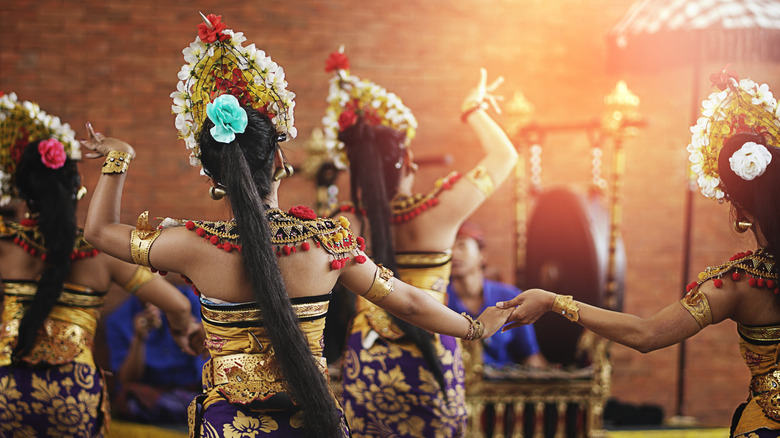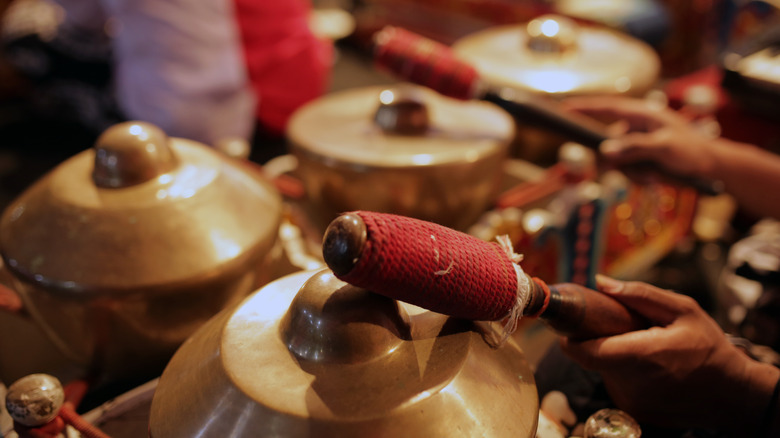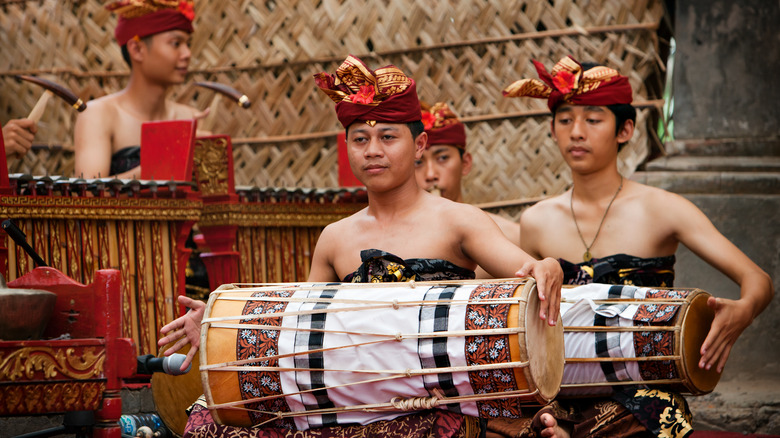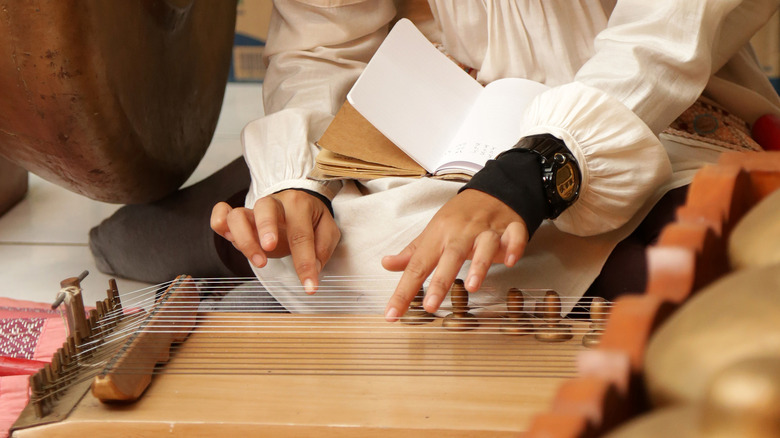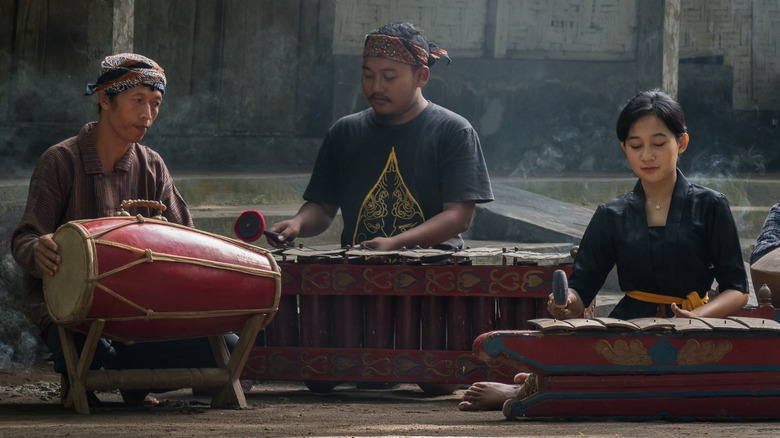The Fascinating History Of Indonesian Gamelan Music
It seems rare, in a media-saturated world, to encounter an artist, writer, musician, what-have-you, that is truly "unique." Maybe you caught wind of a synthwave composer who kind of resembles the grimy noir of Perturbator mixed with the quirky bleep-crackles of early Orbital as composed by the anti-pop sensibilities of Com Truise — or something like that. (And sorry — that music doesn't exist (possibly), but feel free to write it.)
But what if you heard a type of music that you truly hadn't heard before? A type. Not a genre, not a sub-genre, not a niche derivative of a micro-genre. Not even your cousin who's kind of got that one cool track he made with Garageband: no. Something unique enough to make you tilt your head and say, "Hang on, why have I been listening to the same artist for the last 10 years, again?"
Enter gamelan, the music of the Indonesian archipelago, the world's largest cluster of islands at 15,000, per World of Music, and home to a super-diverse 250 million people — Javanese, Sundanese, Indonesian, Madura, and more, as the Indonesian Embassy states. In fact, "gamelan" refers to the region's entire musical heritage, as well as the instruments themselves. It's kind of a catch-all word that really should mean "awesome hammer bell ring and flutes make shiny future sound."
'Unity in Diversity': the music of the Indonesian archipelago
Before we proceed, we've got to ditch those all-too familiar, but of course lovely, major (Ionian mode) and minor (Aeolian mode) musical scales. Then chuck out the whole, achingly overdone "intro-verse-chorus-verse-chorus-bridge-solo-etc.-etc." 16-bar song structure that's come to stuff all of our Western heads. Pretend you're newly arrived on Earth, an alien, and then smile because Balinese gamelan performers like those on YouTube stepped on stage.
Balinese is one of the more often-cited types of gamelan, as far as these things go, possibly because rich tourists love lounging at resorts in Bali. But as World of Music explains, there's an entire array of related music spanning the Indonesian archipelago, especially because the modern nation of Indonesia didn't form until 1945. Before that, there were hundreds of years, full of countlessly different cultural groups throughout the region who developed their own music. Predictably endless colonial incursions by the Portuguese, Dutch, Japanese, and so on, in the end had the effect of unifying Indonesia and creating the modern usage of the term "gamelan." And now? Heck, even former President George W. Bush got in on the fun hitting a metallophone with a little hammer, as Ancient Future shows.
The Indonesian government's slogan "Bhinnéka Tunggal Ika" ("Unity in Diversity") was developed out of necessity to draw together all the country's differing cultural, musical, and ethnic traditions into a unified, national identity.
Gongs, xylophones, singers, masked dances, and more
On a whole, gamelan is largely ensemble-based, like an orchestra. As Ancient Future says, there's a lot of tuned gongs (bonang), metallophones, xylophones, kettle drums, drums similar to conga, flutes, shakers, and more. There's an entire host of interlocking rhythmic and melodic parts — kotèkan — coming in at certain points, leading to particular musical passages, building up, easing off, according to musical notation separating into "male" and "female" parts (nyangsih and polos), phrasal structures with names like Balinese "tutugan" and "ochètan," and other complexities. Suffice it to say: It all represents the cooperation needed to produce harmony and unity, as well as the balance of the sexes.
Gamelan can be accompanied by singers, usually a pesinden (a solo female singer), possibly in tandem with a gerong (male chorus), as this Quora thread discusses. However, that's usually for performance purposes only, like a concert. Pesinden singers (as seen on YouTube) are characterized by the often high-pitched, extreme vibrato and long-held notes that we can see in Japanese enka (posted on YouTube), and Uttar Pradesh (an Indian state) thumri (also on YouTube).
As for gamelan dances, there's a lot of regional variety. As World of Music describes, there's wayang kuli, a type of shadow puppet theater inspired by Hindu mythology, various masked, narrative dances of Java that often portray animals and mystical journeys, and Balinese dances of warriors fighting off evil spirits.
Layers of international musical influences helped craft gamelan
As with many indigenous traditions, there's no way to pinpoint exactly where and when gamelan music started. The modern, multiethnic, multicultural, multilingual (up to 800 different languages in 2010, per Translators without Borders) nation of Indonesia evolved its sophisticated musical heritage over a long, long period of time.
As ThoughtCo says, we know that once the Dutch East India Trading Company made its way into Indonesia and pushed out Portuguese influence in the early 1600s, monarchs such as Mataram's Amangkurat I (1646-1677) put on performances for travelers. Trader Rijklof van Goens, for example, noted a show of "between thirty and fifty instruments," mostly gongs, and an accompaniment of female dancers. Before that, from the mid-1400s Indonesia was influenced by Portuguese merchants who brought with them Western instruments, particularly stringed ones, that got integrated into local music and dubbed "kroncong." Around the same time, during the 15th century, Islam made its way to Indonesia (about 87% of Indonesians currently identify as Muslim, per Statista), which molded traditional music into something more meditative and slow-tempoed, in keeping with Sufi beliefs.
Along with Muslims, Hindus and Buddhists made their way overseas to Indonesia from the 12th to 15th centuries. They carried with them a focus on metallic percussion, particularly the Majapahit Empire (1293-1597), which even had a government office in charge of overseeing the arts, including gamelan.
From the 6th-century Kingdom of Srivijaya to 21st-century Yale
The earliest known record of something resembling gamelan comes from the Kingdom of Srivijaya, a vast maritime empire centered on the island of Sumatra all the way from the 6th-13th centuries CE. Per ThoughtCo, they carved figures of gamelan musicians into bas reliefs at Borobudur Temple, a Buddhist landmark in central Java. Or at least, the figures are holding stringed instruments, metal drums, and flutes, but we have no way of knowing what the music sounded like. Mostly, it was the Srivijayan aristocracy from the 8th-11th centuries that produced such artistry.
As for the instruments themselves, it's suggested that the tradition of metal instruments, rather than wood, developed because Indonesia is super humid. Wood quickly and easily rots. Hence, not only the drums and xylophones, but also the hammers used to play the instruments — "gamels," after which gamelan gets its name — are made of metal.
At present, while gamelan isn't as widely listened to as, let's say, Drake (up to you if this is fair or not), it's actually pretty well known in the West as far as the terrible moniker "world music" is concerned. At Bates College in Lewiston, Maine, students can enroll in a gamelan orchestra and put on performances, as the Bates website shows. Yale, UC San Diego, Cornell, and many more also teach gamelan. Thankfully, this means that lots more people, at least, have the chance to experience the joy of hearing gamelan for the first time.
